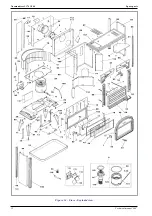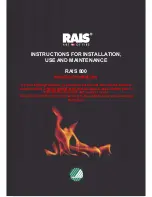
1.4. Operating principle
Furnace oil is fed to the burner floor (fig. 12) where is it
ignited by means of a firestarter. The heat produced by
this flame brings the burner temperature to the required
level to vaporize the fuel. Oil will only burn as a vapour
not a liquid.
Room combustion air enters the burner through the air
inlet holes (# 1).
In the center of the burner is the catalyser (# 4) which
aids in vaporizing the fuel. When the stove is operation,
the catalyser glows red. The stove should not be used
with out both the catalyser (# 4), catalyser top (# 3) and
ring (# 2).
A de-scaling lever (# 5, fig. 9) can be pushed and pulled
in and out as well as turning slightly at the same time to
keep the inlet pipe clear of carbon buildup.
The stove float regulator contains a filter to trap
impurities.
A safety lever controls fuel flow. Oil can only enter the
float chamber when the safety lever is depressed.
Oil temperature variations will affect the oil flow into the
float chamber. A float in the chamber raises the fuel
level available to the burner.
The carburetor is also controlled by a control knob
which turns from “0" (off) to ”6" (high setting).
A draft regulator (# 1, fig. 9) ensures a constant air
intake to the burner regardless of external factors.
4
Technical manual “949”
Normandie ref. 174 10 44
Description of the unit
!
"
#
$
Figure 2 - Burner
1
- Air holes
2
- Upper ring
3
- Catalyser top
4
- Catalyser
5
- Burner
6
- Glow-plug ignitor
(optional)
Figure 3 -Float regulator
A
B
D
C
F
G
E
A
- Control knob
B
- Safety lever
C
- Main float
D
- Safety float
E
- Oil level regulator
F
- Thermostat control
G
- Filter











































